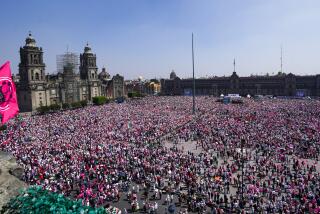Protests erupt after Mexican hero Emiliano Zapata is depicted nude and in high heels

As paintings go, it is tiny — about the size of a cereal box.
But the controversy it has incited is huge.
There, riding bareback on a white horse, is Emiliano Zapata, the Mexican revolutionary leader who, with his big mustache and steely gaze, has long been a symbol here for a certain kind of tough masculinity.
The painting challenges that image. In it, Zapata strikes a sensual pose and is nude except for a silky sash, black high heels and a pink sombrero. The horse is depicted with an erection.
Artist Fabián Cháirez finished the painting in 2013, but it came to public attention only in recent days, after it was installed along with 140 other artworks in a government-curated exhibition at the Palacio de Bellas Artes, the most famous venue for theater, dance and other cultural programming in Mexico City.
No artwork in recent memory here has triggered so much contention, prompting questions about free speech as well as tolerance for diverse representations of gender and sexuality in a culture dominated by machismo.
After Mexico’s Secretariat of Culture used the painting to promote the exhibition on social media and major newspapers published photographs of it, angry mobs descended on the museum.
On Tuesday, about 150 people briefly blocked the museum’s entrance and demanded that authorities take the painting down.
“Burn it! Burn it!” they shouted, waving flags emblazoned with Zapata’s face.
They were later caught on camera punching and kicking members of the lesbian, gay and transgender community who had congregated outside the museum, leaving splatters of blood on the building’s white marble entryway.
LGBT demonstrators returned Wednesday to the museum to show their support for the painting and the artist. “If Zapata were alive, he would be with us,” one sign read.
Meanwhile, in Zapata’s home state of Morelos, his grandson has announced that he plans to sue the government and the artist for “denigrating” his ancestor’s legacy.
“He portrays Gen. Zapata as gay,” said the grandson, Jorge Zapata, who described the painting as a “stupid act.”
“We are not going to allow that,” he said.
So far, Mexican officials have stood by the work. Lucina Jimenez, the director of Bellas Artes, told journalists that “the artist has the right to freedom and curators have the right to build a diverse portrait of a Mexican figure.”
She said the exhibition would remain open, and invited protesters to go spend time with the painting and engage in a dialogue about it.
Even Mexican President Andrés Manuel López Obrador weighed in.
“There can be no censorship,” he said at his daily news conference Wednesday morning, adding that he was comfortable with the artist’s portrayal of Zapata.
“I am a lover of freedom,” he said.
He said that he planned to instruct his secretary of culture to speak with Zapata’s family about the painting.
The controversy comes amid intensifying culture wars in Mexico, where conservative political movements have sought to limit rights for lesbians and gays.
In recent months, women protesting sexual violence have led major demonstrations in the capital, defacing subway stations and national monuments with pink graffiti and sparking debates even among leftists about whether they should be prosecuted for property damage.
The debate over the painting comes as Mexico marks the 100th anniversary of the death of Zapata, who in 1910 helped launch the Mexican Revolution, a national uprising against successive governments, calling for land to be redistributed to the peasants.
The revolution, which led to the overthrow of dictator Porfirio Diaz, ended a decade later.
Zapata’s guerrilla tactics and death in a hail of bullets in 1919 all contributed to his mythology as a brave and masculine leader who was unafraid to fight.
The exhibit, titled “Emiliano. Zapata After Zapata,” includes artists from dozens of countries and sought to include different perspectives on such a key player in Mexican history.
The Cháirez painting is included in a section of the show called “other revolutions,” which curators said offers “homosexual deconstructions” of both nationalism and “models of hegemonic masculinity.”
Cháirez, 32, who has sought to portray the softer side of different male Mexican archetypes, from gang members to priests, used a transgender woman as a model for the painting.
In a statement, he said that the angry response to his work highlights the misogyny and fear of difference in Mexican culture.
“What’s offensive about it?” he said. “It’s that he is feminized.”
He has called for supporters of the painting to rally outside the museum Friday.
“We are in an ultra-sexist society,” he said, adding that “there are some people who experience discomfort from bodies that don’t obey the rules.”
More to Read
Start your day right
Sign up for Essential California for news, features and recommendations from the L.A. Times and beyond in your inbox six days a week.
You may occasionally receive promotional content from the Los Angeles Times.







